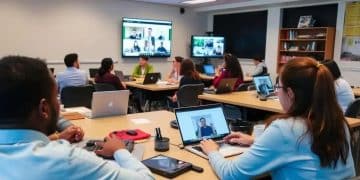Digital education programs for teachers: enhance your skills

Digital education programs for teachers provide essential skills to enhance teaching methods, incorporate technology effectively, and engage students more actively in their learning process.
Digital education programs for teachers are changing the way we think about professional development. Have you ever wondered how these programs can elevate your teaching and engage your students more effectively? Let’s dive in!
Key benefits of digital education programs
Digital education programs offer a transformative experience for teachers, allowing them to adapt to the evolving landscape of education. By engaging with these programs, teachers can not only enhance their skills but also develop innovative teaching methods that can captivate their students. One of the key benefits of these programs is the ability to integrate technology effectively in the classroom.
Enhancing Teaching Skills
Participating in digital education programs is a great way for teachers to refresh and enhance their teaching skills. They gain exposure to the latest tools and techniques that can make their lessons more engaging.
- Access to updated resources and materials
- Opportunities to learn from experienced educators
- Networking with other professionals
Another significant advantage is the flexibility these programs offer. Many courses are designed to fit a teacher’s busy schedule, allowing them to learn at their own pace. This flexibility means teachers can continue to meet their classroom responsibilities while also investing in their professional development.
Building Technological Competence
As technology becomes more integral to education, having a strong grasp of digital tools is essential. Digital education programs focus on equipping teachers with the skills necessary to leverage technology effectively. This knowledge can lead to enhanced student interaction and success.
Importantly, teachers who engage in these programs may also find that they are better prepared to face challenges in the classroom. The training often includes practical strategies for managing digital tools, thus enriching the learning environment.
Ultimately, the digital education programs are not just about improving skills; they are about fostering a culture of lifelong learning among educators. By embracing these opportunities, teachers can turn challenges into exciting opportunities for growth.
How to choose the right program

Choosing the right digital education program can seem overwhelming, but it’s essential for teachers who want to improve their skills. Knowing what to look for can make this decision easier and more effective. Start by assessing your own needs and goals as an educator.
Identify Your Learning Objectives
Before selecting a program, it’s important to identify your specific learning objectives. Do you want to learn about integrating technology or enhancing classroom management skills? Understanding your primary goals will help you narrow down the options.
- Define what you hope to achieve with training
- Consider what skills are most relevant to your current teaching situation
- Think about any gaps in your knowledge that need to be addressed
Next, analyze the program’s content. Make sure it covers the topics you want to learn about. Look for programs that align closely with current teaching standards and utilize engaging teaching methods.
Research Options and Reviews
Conduct thorough research on available programs. Check for reviews and testimonials from other teachers who have completed the course. This feedback can provide valuable insights into the quality and relevancy of the training.
Pay attention to the following:
- Reputation of the institution offering the program
- Availability of resources, such as online support and materials
- Flexibility in scheduling and course structure
Finally, consider whether the program offers accreditation or certification upon completion. This can add value to your professional credentials and ensure that you are receiving a quality education.
Successfully implementing new skills in the classroom
Successfully implementing new skills in the classroom is crucial for enhancing the learning experience. After participating in digital education programs, teachers may feel excited to try their newly acquired skills. However, applying what you learn can be challenging without a clear plan.
Start with a Plan
Creating a structured plan for implementation is vital. Begin by identifying the specific skills you want to apply, and then outline steps to incorporate them into your lessons. Consider the abilities of your students and how these new tools can meet their needs.
- Choose lessons where new skills can integrate easily
- Set clear objectives that align with your learning goals
- Gather resources and materials that support these skills
Next, experiment in small groups or pilot programs. Testing new teaching methods on a smaller scale allows for adjustments before a full-class implementation. By gathering feedback from a few students, you can refine your approach.
Incorporating Technology Effectively
Digital tools can transform traditional lessons into interactive experiences. Use technology to engage students and enhance understanding. For instance, integrating multimedia presentations can appeal to different learning styles.
Be sure to provide students with the necessary guidance and support when using new tools. This includes:
- Offering tutorials or demonstrations on new digital platforms
- Encouraging collaboration among students with different skill levels
- Providing ongoing assistance as students practice using the tools
As you implement new skills, be open to adjusting your techniques based on classroom dynamics. Flexibility is key to enhancing student engagement and achieving learning objectives.
Staying updated with ongoing digital trends

Staying updated with ongoing digital trends is essential for teachers who want to provide the best for their students. The world of technology evolves rapidly, and keeping pace can enhance teaching methods and improve student engagement.
Follow Trusted Sources
Begin by following reliable sources of information. Websites, blogs, and online communities can provide valuable insights into the latest trends in education technology. Knowing where to look helps you stay informed.
- Subscribe to educational technology newsletters
- Join professional organizations that focus on digital learning
- Participate in webinars and online workshops
Additionally, networking with other educators can be highly beneficial. Engaging in discussions about new technologies can introduce you to tools and practices you might not have considered.
Utilize Social Media
Social media platforms are also excellent for staying up-to-date. Follow thought leaders in education technology on Twitter or LinkedIn. This way, you can receive real-time updates and diverse perspectives.
Join groups or forums dedicated to digital education. Sharing experiences and resources can lead to discovering innovative applications and tools.
As part of staying current, don’t forget to continually assess your own use of technology in the classroom. Reflect on how new trends can enhance your teaching style or improve student learning outcomes.
Finally, consider integrating your findings into your lesson plans. Stay flexible and open to adopting new approaches as they arise. This adaptability will keep your teaching fresh and relevant.
FAQ – Questions about digital education programs for teachers
What are digital education programs?
Digital education programs are training courses designed to help teachers enhance their skills using technology in the classroom.
How can I choose the right digital education program?
To choose the right program, identify your specific learning goals, research available options, and consider reviews and recommendations from other educators.
Why is staying updated with digital trends important?
Staying updated with digital trends ensures that educators are using the most effective tools and methods to engage students and improve learning outcomes.
How can I implement new skills from these programs in my classroom?
Start by creating a structured plan, integrating new skills gradually, and seeking feedback from your students to refine your approach.





